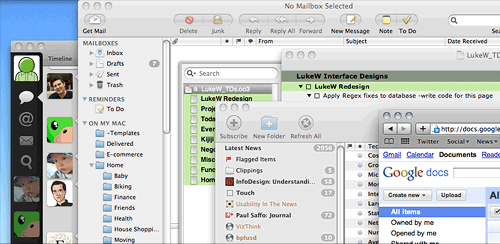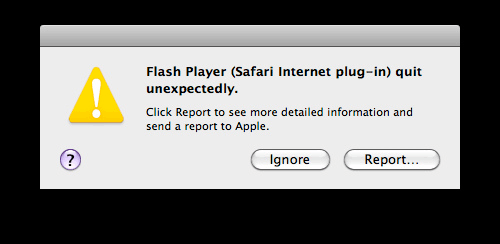Apple's iPad is an early (but big) step toward the future of personal computing. But you can't move into the future if you are weighed down by the past. So it's quite possible that several of the technical limitations in the current iPad are actually deliberate design decisions made by Apple to ensure the future of personal computing arrives without the issues of today.
Well what's wrong with personal computing today? Complex operating system interfaces, technical input devices, security issues, and frequent crashes -to name just a few things. But how do the iPad's technical limitations potentially address these issues?
Running Multiple Apps at Once
The iPad follows the iPhone's application model. So you can't run two different programs at the same time and switch between them. It's one app at a time. Why would Apple do this? The iPad clearly has enough screen real estate to support multiple apps at once.

Ever have a computer screen that looks like the image above? Multiple apps open. Each with multiple windows. Working in this environment means a lot of time spent managing windows, switching between applications and generally clicking all over the screen but getting no work done. The iPad has none of that.
In fact, the iPad goes even further by abstracting away the file system entirely. "Rather than saving their documents into a file system, apps on iPad save all their documents within their own installation directory. Delete the app and you'll clean out all of its related files."
In the future, file management can be even easier once all your documents are in the cloud. No need to worry about backing up, not having the file you need with you, or duplicating files across multiple synched devices. The iPad has taken a first step toward this model as iPad apps can share documents wirelessly.
Not Supporting Flash
The iPad boasts having the best Web browsing experience of any device. Yet it does not support Flash which powers video, interactive charts, games, and more on many Web sites. Why would Apple not support Flash?

Turns out, Flash is the single leading source of application crashes on Mac OS X. It's a component Apple can't fix because they don't own it. It belongs to Adobe. "Apple controls the entire source code to the iPhone OS. If there’s a bug, they can fix it. If something is slow, they can optimize or re-write it." Not the case with Flash.
Update: Supposedly Steve Jobs confirmed this reason at an Apple Town Hall: "Apple does not support Flash because it is so buggy, he says. Whenever a Mac crashes more often than not it’s because of Flash. The world is moving to HTML5." HTML5's audio, video, and canvas elements provide open, standards-based ways to provide most of the functionality Flash adds online. Many Web publishers are actively supporting these standards.
The App Store Review Process
To get an application on the iPad, developers have to submit it to Apple for approval. Only then will it get published and be made available to users. Why would Apple prevent access to all applications? Why not just allow any application into the App Store?
At the start of 2009, there were 2.6 million malicious code threats online (viruses, trojans, etc.). 921,143 were added in the fourth quarter alone. In December 2009, a malicious phishing app on Google's Android platform was able to harvest bank login details from people who downloaded the app. The incident raised questions about whether a tighter vetting process is needed for the Android Marketplace.
Having a review process not only keeps malicious apps out, it also keeps buggy apps out. Again limiting the number of crashes people experience on the iPad and thereby preserving a great user experience.
Of course, you can't mention Apple's App Store review process without encountering the common assertion that, in technology (and especially the Web) "completely open" is better than "controlled".
Now, I'm as big a fan of the open Web as anyone. But that doesn't mean I don't appreciate or understand the value of closed systems. Closed systems enable companies to do seamless integration without putting the burden on their customers. An open system (like Android on smart phones) enables you to do what you like. It's like Linux on the phone -with all that entails.
Apple, instead, makes their living by tightly controlling the experience of their customers. It's why everyone praises their designs. From top to bottom, hardware to software -you get an integrated experience. Without this control, Apple could not be what it is today.
No USB Ports
The iPad only supports USB connections through a camera connection kit. Why not simply allow any device to plug into the iPad through several ports? Anyone who has had to manage disc drivers, device software installs, and upgrades for peripherals knows the pain they can cause. To add insult to injury, they make your computing life look like a rat's nest of wires (image by SinaX).

No Onboard Camera
I don't know why there is no camera on the iPad. It could be a cost issue but Apple sells the iPod Nano with a built-in video camera for $150. Guess we'll have to wait for v2 of the iPad.
A Simpler Computer
So while people are likely to continue assailing the iPad for these technical limitations, perhaps there's good reason behind Apple's decisions. Together they create a computing experience with less UI management, less crashes, less malicious apps, less device management, and thereby less complexity.
Thanks to Fraser Speirs' great retort to the negative reviews of the iPad that got me thinking about this topic.